SASOL in the Global Business Environment: A Strategic Analysis Report
VerifiedAdded on 2023/06/05
|10
|1782
|452
Report
AI Summary
This report provides a comprehensive analysis of SASOL's operations within the global business environment. It delves into the drivers and challenges of globalization, utilizing the PESTLE framework to assess global influences on the company. The report examines the impact of digital technology, cultural and governance structures through McKinsey's 7s model, and the application of Hofstede's Dimensions of Culture. Furthermore, it evaluates sustainable and ethical factors affecting SASOL's decision-making processes and critically assesses various strategic expansion routes available to the organization. The analysis concludes with key insights into how the global business environment shapes SASOL's functions, structure, culture, and strategic choices.
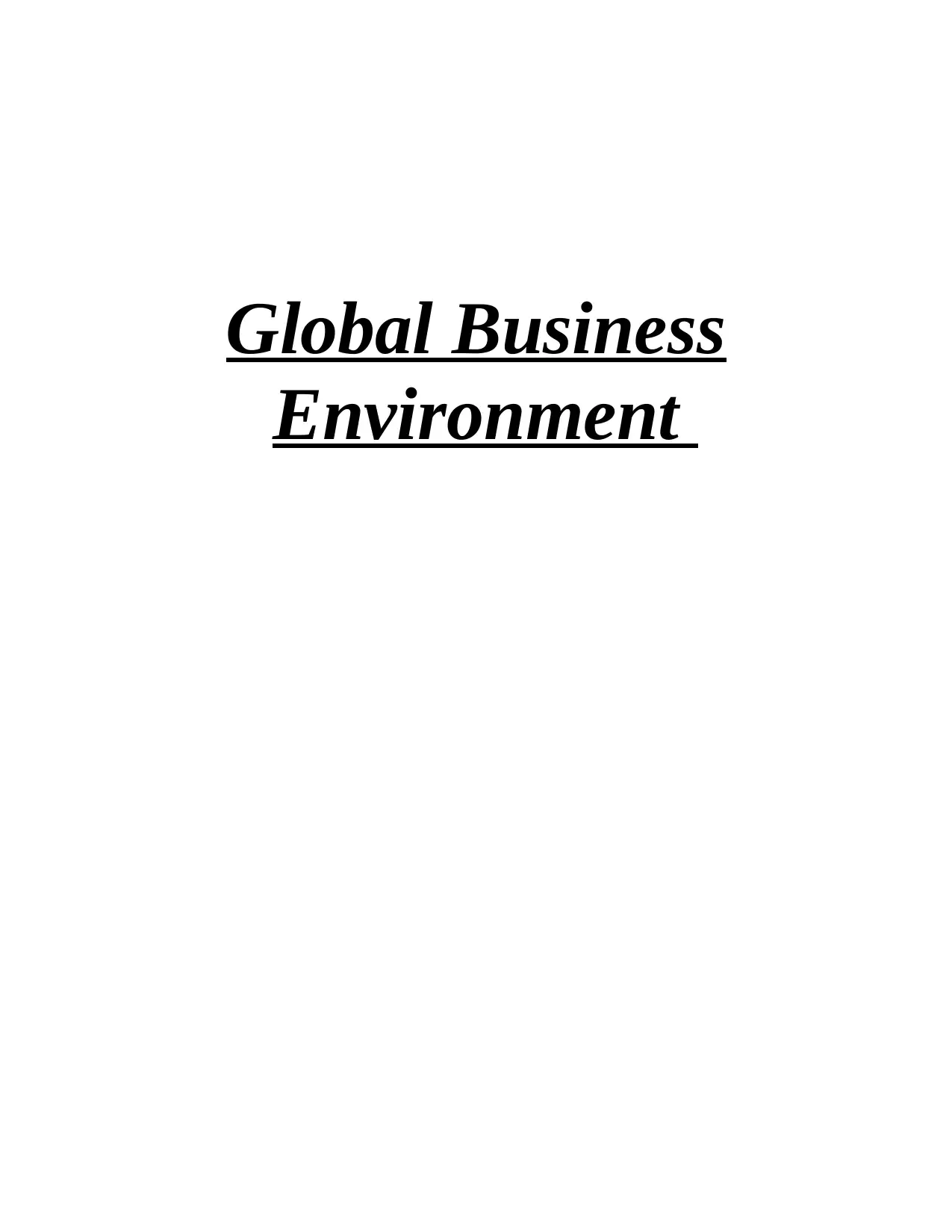
Global Business
Environment
Environment
Paraphrase This Document
Need a fresh take? Get an instant paraphrase of this document with our AI Paraphraser
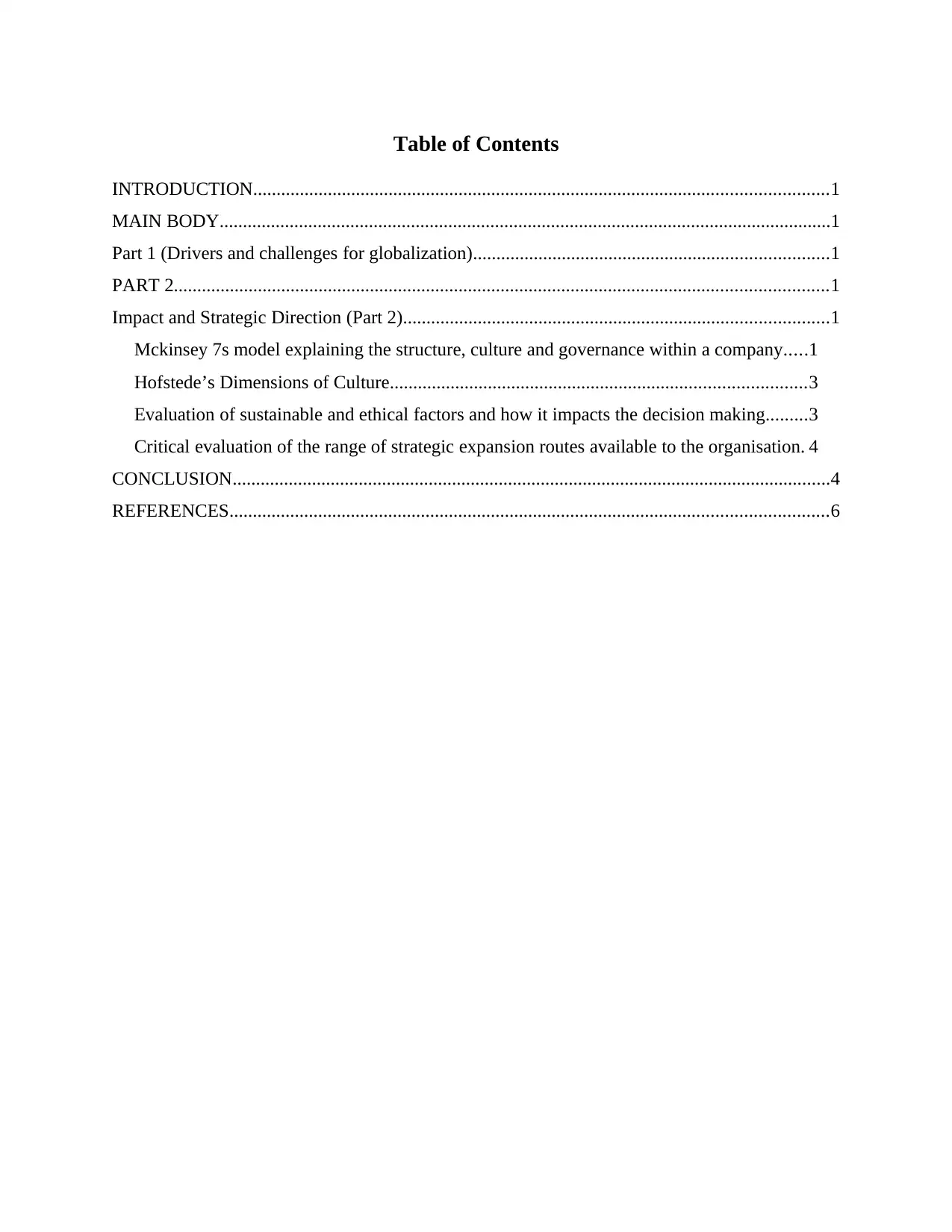
Table of Contents
INTRODUCTION...........................................................................................................................1
MAIN BODY...................................................................................................................................1
Part 1 (Drivers and challenges for globalization)............................................................................1
PART 2............................................................................................................................................1
Impact and Strategic Direction (Part 2)...........................................................................................1
Mckinsey 7s model explaining the structure, culture and governance within a company.....1
Hofstede’s Dimensions of Culture.........................................................................................3
Evaluation of sustainable and ethical factors and how it impacts the decision making.........3
Critical evaluation of the range of strategic expansion routes available to the organisation. 4
CONCLUSION................................................................................................................................4
REFERENCES................................................................................................................................6
INTRODUCTION...........................................................................................................................1
MAIN BODY...................................................................................................................................1
Part 1 (Drivers and challenges for globalization)............................................................................1
PART 2............................................................................................................................................1
Impact and Strategic Direction (Part 2)...........................................................................................1
Mckinsey 7s model explaining the structure, culture and governance within a company.....1
Hofstede’s Dimensions of Culture.........................................................................................3
Evaluation of sustainable and ethical factors and how it impacts the decision making.........3
Critical evaluation of the range of strategic expansion routes available to the organisation. 4
CONCLUSION................................................................................................................................4
REFERENCES................................................................................................................................6
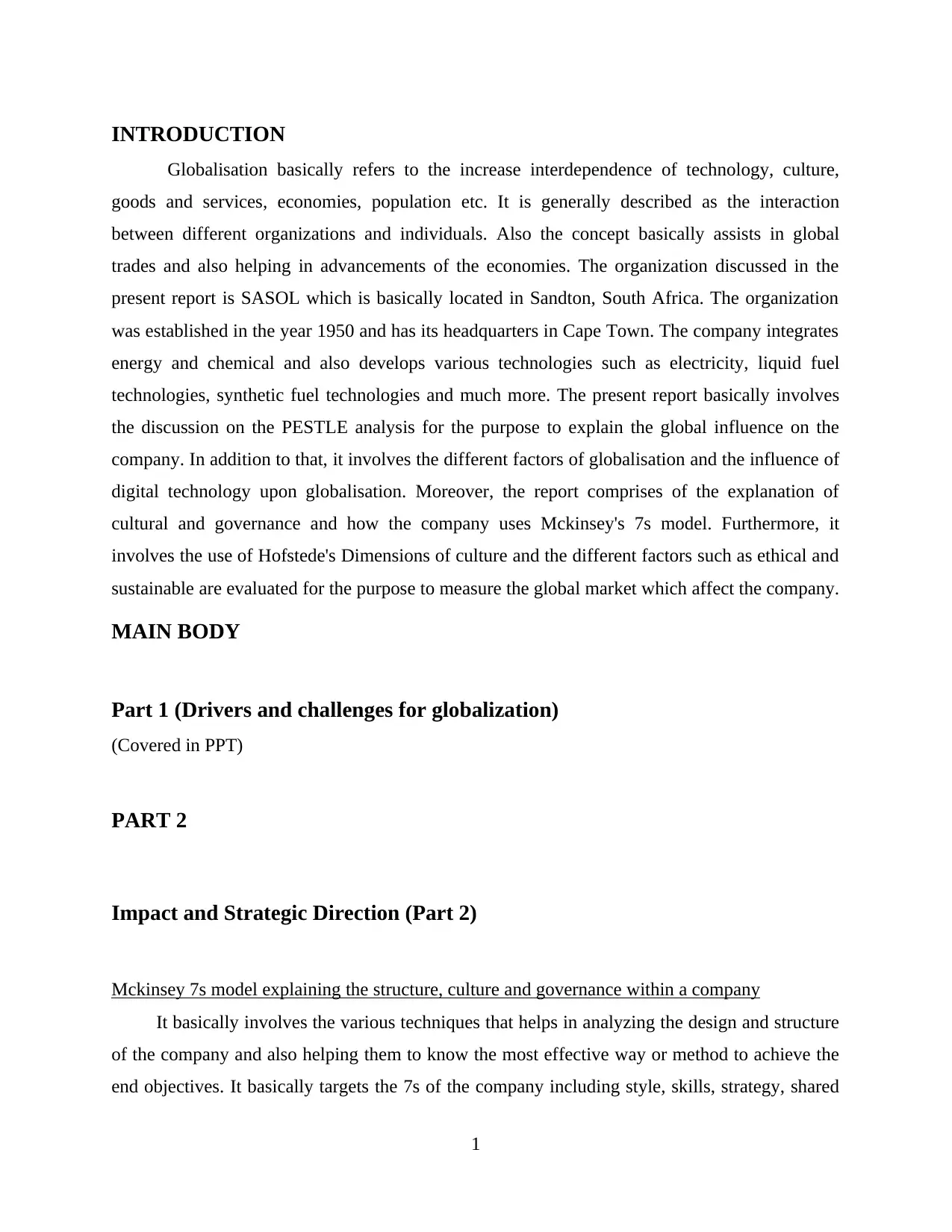
INTRODUCTION
Globalisation basically refers to the increase interdependence of technology, culture,
goods and services, economies, population etc. It is generally described as the interaction
between different organizations and individuals. Also the concept basically assists in global
trades and also helping in advancements of the economies. The organization discussed in the
present report is SASOL which is basically located in Sandton, South Africa. The organization
was established in the year 1950 and has its headquarters in Cape Town. The company integrates
energy and chemical and also develops various technologies such as electricity, liquid fuel
technologies, synthetic fuel technologies and much more. The present report basically involves
the discussion on the PESTLE analysis for the purpose to explain the global influence on the
company. In addition to that, it involves the different factors of globalisation and the influence of
digital technology upon globalisation. Moreover, the report comprises of the explanation of
cultural and governance and how the company uses Mckinsey's 7s model. Furthermore, it
involves the use of Hofstede's Dimensions of culture and the different factors such as ethical and
sustainable are evaluated for the purpose to measure the global market which affect the company.
MAIN BODY
Part 1 (Drivers and challenges for globalization)
(Covered in PPT)
PART 2
Impact and Strategic Direction (Part 2)
Mckinsey 7s model explaining the structure, culture and governance within a company
It basically involves the various techniques that helps in analyzing the design and structure
of the company and also helping them to know the most effective way or method to achieve the
end objectives. It basically targets the 7s of the company including style, skills, strategy, shared
1
Globalisation basically refers to the increase interdependence of technology, culture,
goods and services, economies, population etc. It is generally described as the interaction
between different organizations and individuals. Also the concept basically assists in global
trades and also helping in advancements of the economies. The organization discussed in the
present report is SASOL which is basically located in Sandton, South Africa. The organization
was established in the year 1950 and has its headquarters in Cape Town. The company integrates
energy and chemical and also develops various technologies such as electricity, liquid fuel
technologies, synthetic fuel technologies and much more. The present report basically involves
the discussion on the PESTLE analysis for the purpose to explain the global influence on the
company. In addition to that, it involves the different factors of globalisation and the influence of
digital technology upon globalisation. Moreover, the report comprises of the explanation of
cultural and governance and how the company uses Mckinsey's 7s model. Furthermore, it
involves the use of Hofstede's Dimensions of culture and the different factors such as ethical and
sustainable are evaluated for the purpose to measure the global market which affect the company.
MAIN BODY
Part 1 (Drivers and challenges for globalization)
(Covered in PPT)
PART 2
Impact and Strategic Direction (Part 2)
Mckinsey 7s model explaining the structure, culture and governance within a company
It basically involves the various techniques that helps in analyzing the design and structure
of the company and also helping them to know the most effective way or method to achieve the
end objectives. It basically targets the 7s of the company including style, skills, strategy, shared
1
⊘ This is a preview!⊘
Do you want full access?
Subscribe today to unlock all pages.

Trusted by 1+ million students worldwide
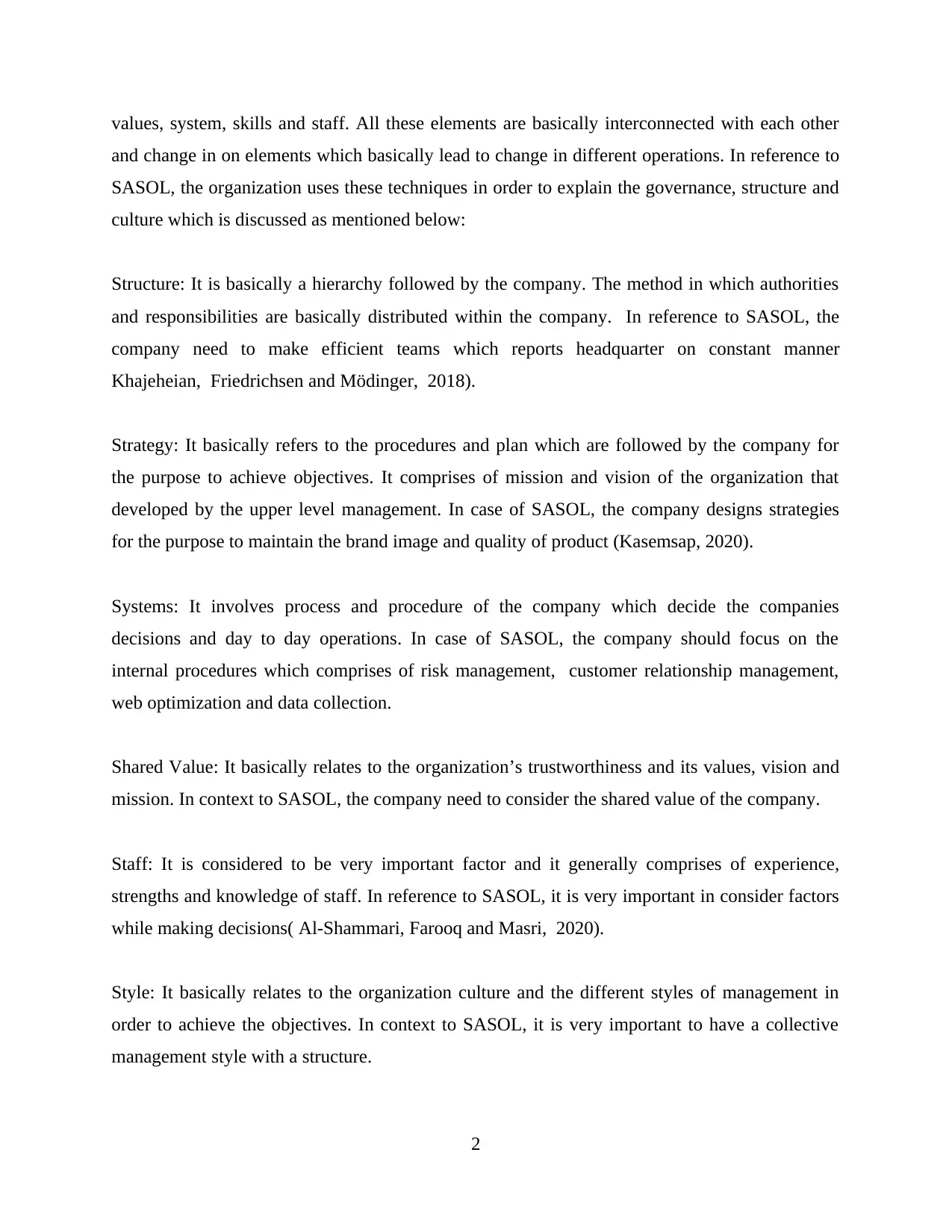
values, system, skills and staff. All these elements are basically interconnected with each other
and change in on elements which basically lead to change in different operations. In reference to
SASOL, the organization uses these techniques in order to explain the governance, structure and
culture which is discussed as mentioned below:
Structure: It is basically a hierarchy followed by the company. The method in which authorities
and responsibilities are basically distributed within the company. In reference to SASOL, the
company need to make efficient teams which reports headquarter on constant manner
Khajeheian, Friedrichsen and Mödinger, 2018).
Strategy: It basically refers to the procedures and plan which are followed by the company for
the purpose to achieve objectives. It comprises of mission and vision of the organization that
developed by the upper level management. In case of SASOL, the company designs strategies
for the purpose to maintain the brand image and quality of product (Kasemsap, 2020).
Systems: It involves process and procedure of the company which decide the companies
decisions and day to day operations. In case of SASOL, the company should focus on the
internal procedures which comprises of risk management, customer relationship management,
web optimization and data collection.
Shared Value: It basically relates to the organization’s trustworthiness and its values, vision and
mission. In context to SASOL, the company need to consider the shared value of the company.
Staff: It is considered to be very important factor and it generally comprises of experience,
strengths and knowledge of staff. In reference to SASOL, it is very important in consider factors
while making decisions( Al-Shammari, Farooq and Masri, 2020).
Style: It basically relates to the organization culture and the different styles of management in
order to achieve the objectives. In context to SASOL, it is very important to have a collective
management style with a structure.
2
and change in on elements which basically lead to change in different operations. In reference to
SASOL, the organization uses these techniques in order to explain the governance, structure and
culture which is discussed as mentioned below:
Structure: It is basically a hierarchy followed by the company. The method in which authorities
and responsibilities are basically distributed within the company. In reference to SASOL, the
company need to make efficient teams which reports headquarter on constant manner
Khajeheian, Friedrichsen and Mödinger, 2018).
Strategy: It basically refers to the procedures and plan which are followed by the company for
the purpose to achieve objectives. It comprises of mission and vision of the organization that
developed by the upper level management. In case of SASOL, the company designs strategies
for the purpose to maintain the brand image and quality of product (Kasemsap, 2020).
Systems: It involves process and procedure of the company which decide the companies
decisions and day to day operations. In case of SASOL, the company should focus on the
internal procedures which comprises of risk management, customer relationship management,
web optimization and data collection.
Shared Value: It basically relates to the organization’s trustworthiness and its values, vision and
mission. In context to SASOL, the company need to consider the shared value of the company.
Staff: It is considered to be very important factor and it generally comprises of experience,
strengths and knowledge of staff. In reference to SASOL, it is very important in consider factors
while making decisions( Al-Shammari, Farooq and Masri, 2020).
Style: It basically relates to the organization culture and the different styles of management in
order to achieve the objectives. In context to SASOL, it is very important to have a collective
management style with a structure.
2
Paraphrase This Document
Need a fresh take? Get an instant paraphrase of this document with our AI Paraphraser
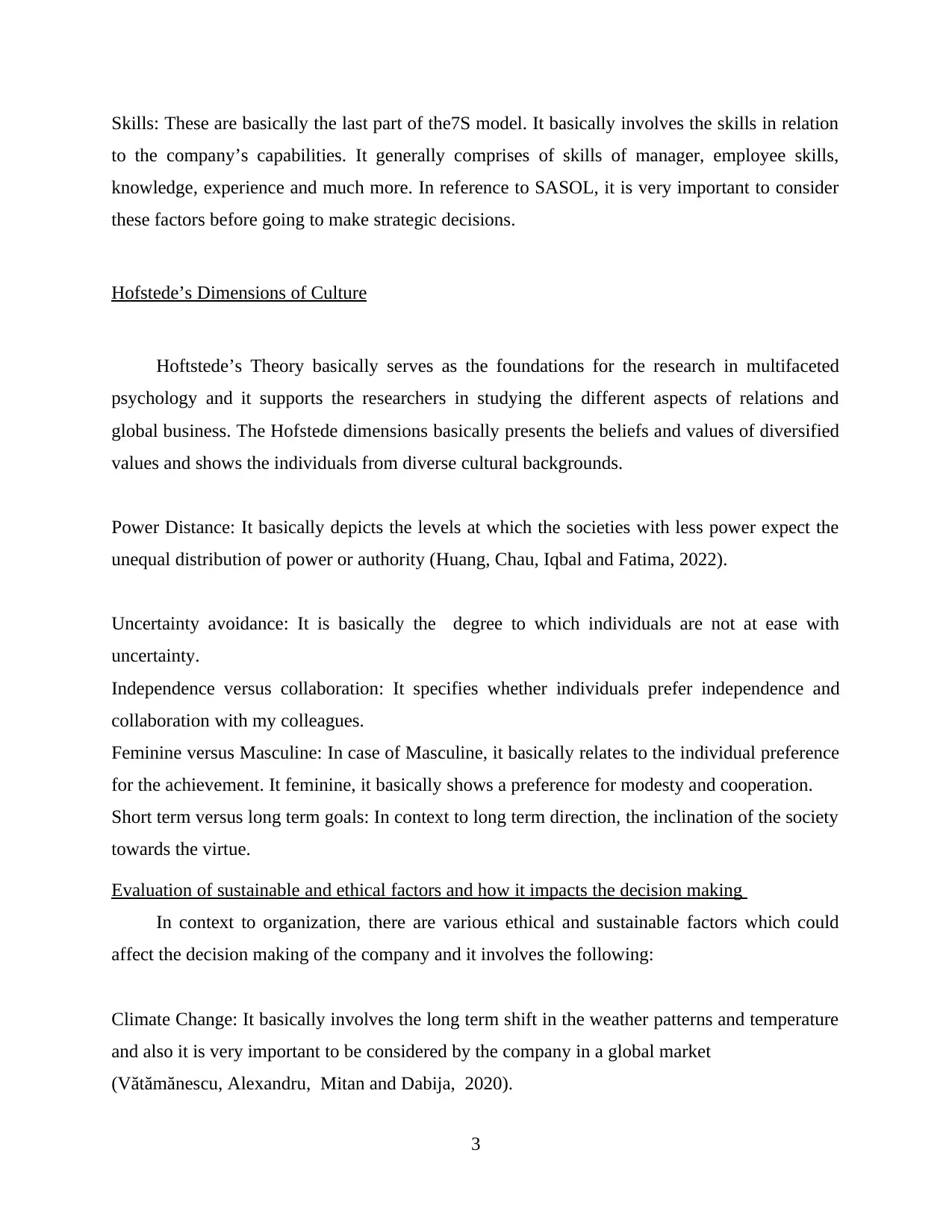
Skills: These are basically the last part of the7S model. It basically involves the skills in relation
to the company’s capabilities. It generally comprises of skills of manager, employee skills,
knowledge, experience and much more. In reference to SASOL, it is very important to consider
these factors before going to make strategic decisions.
Hofstede’s Dimensions of Culture
Hoftstede’s Theory basically serves as the foundations for the research in multifaceted
psychology and it supports the researchers in studying the different aspects of relations and
global business. The Hofstede dimensions basically presents the beliefs and values of diversified
values and shows the individuals from diverse cultural backgrounds.
Power Distance: It basically depicts the levels at which the societies with less power expect the
unequal distribution of power or authority (Huang, Chau, Iqbal and Fatima, 2022).
Uncertainty avoidance: It is basically the degree to which individuals are not at ease with
uncertainty.
Independence versus collaboration: It specifies whether individuals prefer independence and
collaboration with my colleagues.
Feminine versus Masculine: In case of Masculine, it basically relates to the individual preference
for the achievement. It feminine, it basically shows a preference for modesty and cooperation.
Short term versus long term goals: In context to long term direction, the inclination of the society
towards the virtue.
Evaluation of sustainable and ethical factors and how it impacts the decision making
In context to organization, there are various ethical and sustainable factors which could
affect the decision making of the company and it involves the following:
Climate Change: It basically involves the long term shift in the weather patterns and temperature
and also it is very important to be considered by the company in a global market
(Vătămănescu, Alexandru, Mitan and Dabija, 2020).
3
to the company’s capabilities. It generally comprises of skills of manager, employee skills,
knowledge, experience and much more. In reference to SASOL, it is very important to consider
these factors before going to make strategic decisions.
Hofstede’s Dimensions of Culture
Hoftstede’s Theory basically serves as the foundations for the research in multifaceted
psychology and it supports the researchers in studying the different aspects of relations and
global business. The Hofstede dimensions basically presents the beliefs and values of diversified
values and shows the individuals from diverse cultural backgrounds.
Power Distance: It basically depicts the levels at which the societies with less power expect the
unequal distribution of power or authority (Huang, Chau, Iqbal and Fatima, 2022).
Uncertainty avoidance: It is basically the degree to which individuals are not at ease with
uncertainty.
Independence versus collaboration: It specifies whether individuals prefer independence and
collaboration with my colleagues.
Feminine versus Masculine: In case of Masculine, it basically relates to the individual preference
for the achievement. It feminine, it basically shows a preference for modesty and cooperation.
Short term versus long term goals: In context to long term direction, the inclination of the society
towards the virtue.
Evaluation of sustainable and ethical factors and how it impacts the decision making
In context to organization, there are various ethical and sustainable factors which could
affect the decision making of the company and it involves the following:
Climate Change: It basically involves the long term shift in the weather patterns and temperature
and also it is very important to be considered by the company in a global market
(Vătămănescu, Alexandru, Mitan and Dabija, 2020).
3
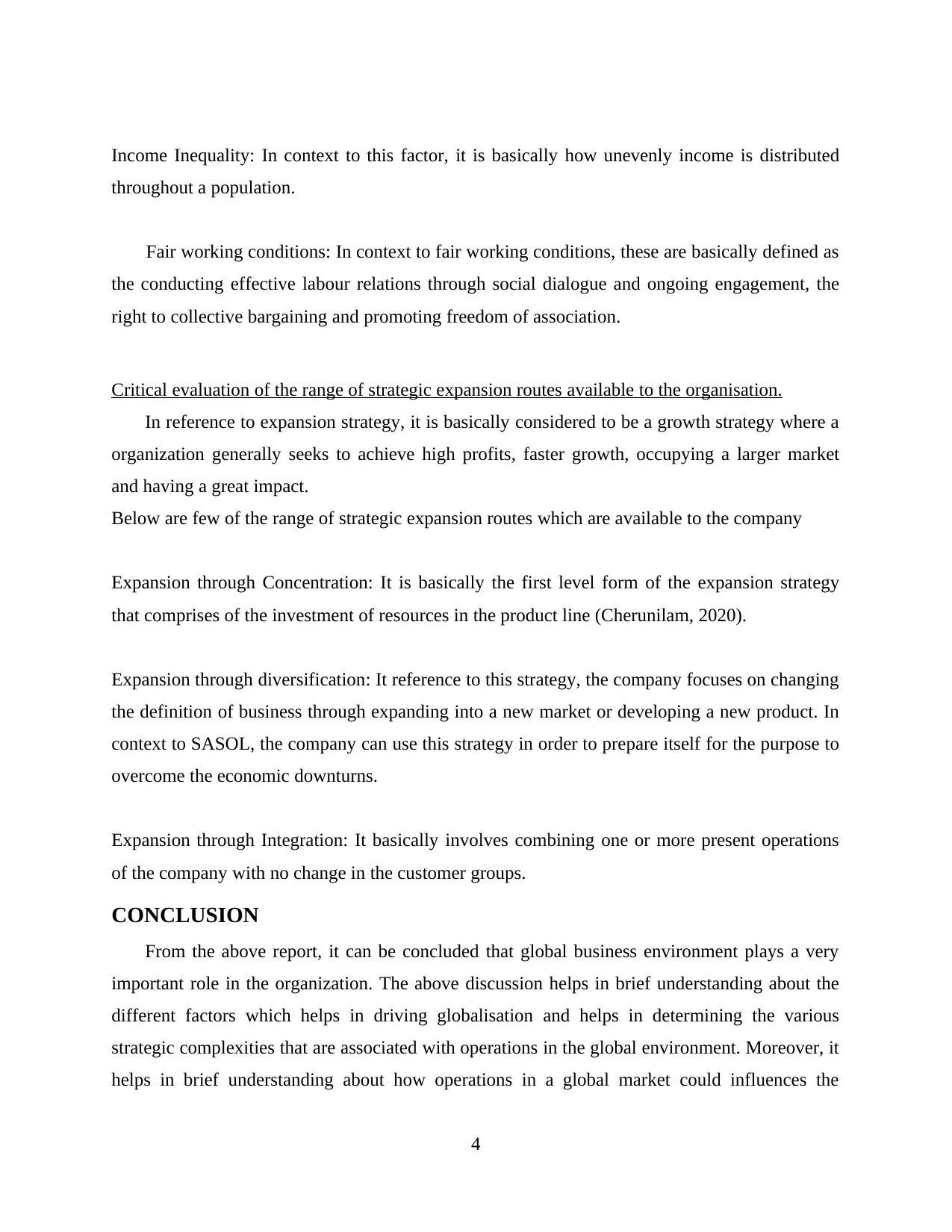
Income Inequality: In context to this factor, it is basically how unevenly income is distributed
throughout a population.
Fair working conditions: In context to fair working conditions, these are basically defined as
the conducting effective labour relations through social dialogue and ongoing engagement, the
right to collective bargaining and promoting freedom of association.
Critical evaluation of the range of strategic expansion routes available to the organisation.
In reference to expansion strategy, it is basically considered to be a growth strategy where a
organization generally seeks to achieve high profits, faster growth, occupying a larger market
and having a great impact.
Below are few of the range of strategic expansion routes which are available to the company
Expansion through Concentration: It is basically the first level form of the expansion strategy
that comprises of the investment of resources in the product line (Cherunilam, 2020).
Expansion through diversification: It reference to this strategy, the company focuses on changing
the definition of business through expanding into a new market or developing a new product. In
context to SASOL, the company can use this strategy in order to prepare itself for the purpose to
overcome the economic downturns.
Expansion through Integration: It basically involves combining one or more present operations
of the company with no change in the customer groups.
CONCLUSION
From the above report, it can be concluded that global business environment plays a very
important role in the organization. The above discussion helps in brief understanding about the
different factors which helps in driving globalisation and helps in determining the various
strategic complexities that are associated with operations in the global environment. Moreover, it
helps in brief understanding about how operations in a global market could influences the
4
throughout a population.
Fair working conditions: In context to fair working conditions, these are basically defined as
the conducting effective labour relations through social dialogue and ongoing engagement, the
right to collective bargaining and promoting freedom of association.
Critical evaluation of the range of strategic expansion routes available to the organisation.
In reference to expansion strategy, it is basically considered to be a growth strategy where a
organization generally seeks to achieve high profits, faster growth, occupying a larger market
and having a great impact.
Below are few of the range of strategic expansion routes which are available to the company
Expansion through Concentration: It is basically the first level form of the expansion strategy
that comprises of the investment of resources in the product line (Cherunilam, 2020).
Expansion through diversification: It reference to this strategy, the company focuses on changing
the definition of business through expanding into a new market or developing a new product. In
context to SASOL, the company can use this strategy in order to prepare itself for the purpose to
overcome the economic downturns.
Expansion through Integration: It basically involves combining one or more present operations
of the company with no change in the customer groups.
CONCLUSION
From the above report, it can be concluded that global business environment plays a very
important role in the organization. The above discussion helps in brief understanding about the
different factors which helps in driving globalisation and helps in determining the various
strategic complexities that are associated with operations in the global environment. Moreover, it
helps in brief understanding about how operations in a global market could influences the
4
⊘ This is a preview!⊘
Do you want full access?
Subscribe today to unlock all pages.

Trusted by 1+ million students worldwide
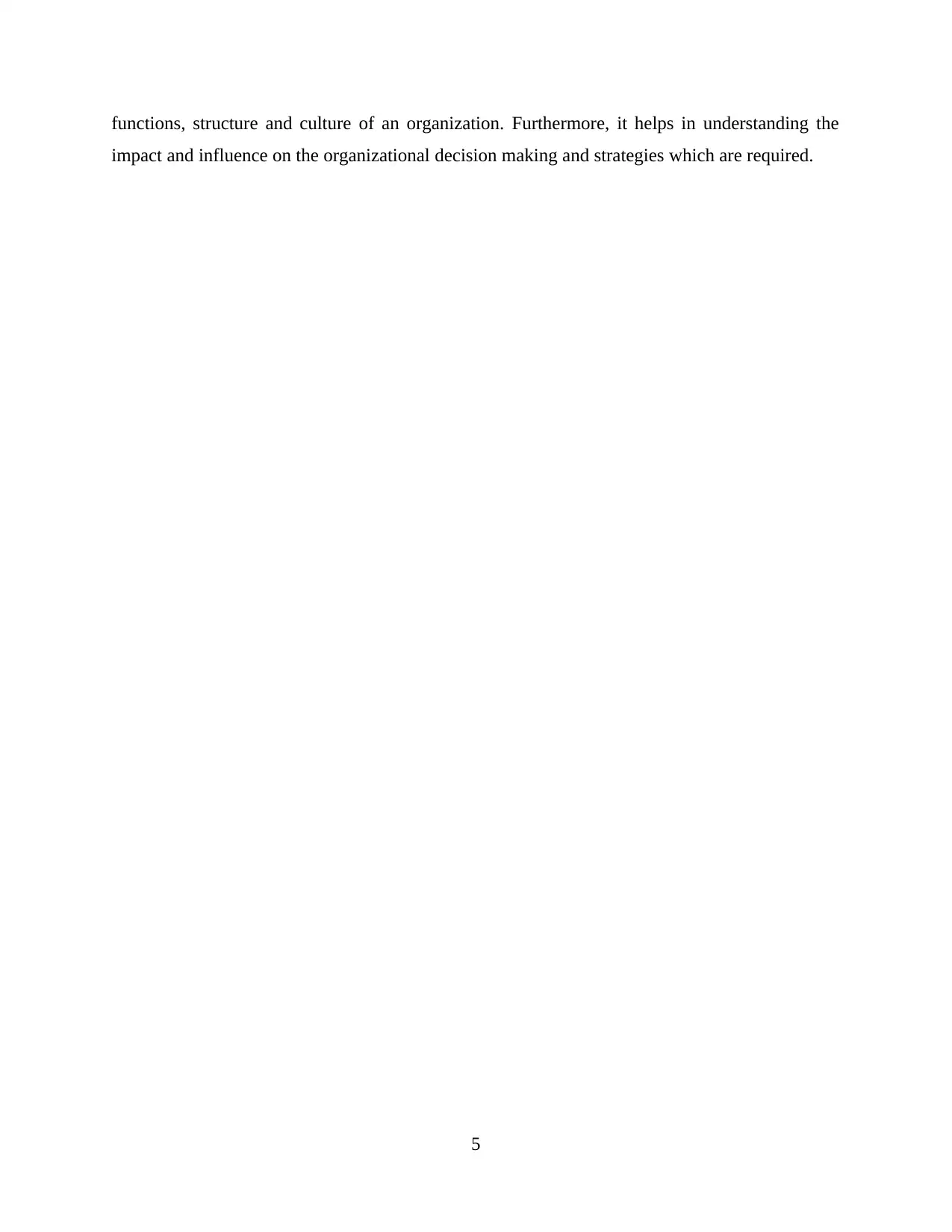
functions, structure and culture of an organization. Furthermore, it helps in understanding the
impact and influence on the organizational decision making and strategies which are required.
5
impact and influence on the organizational decision making and strategies which are required.
5
Paraphrase This Document
Need a fresh take? Get an instant paraphrase of this document with our AI Paraphraser
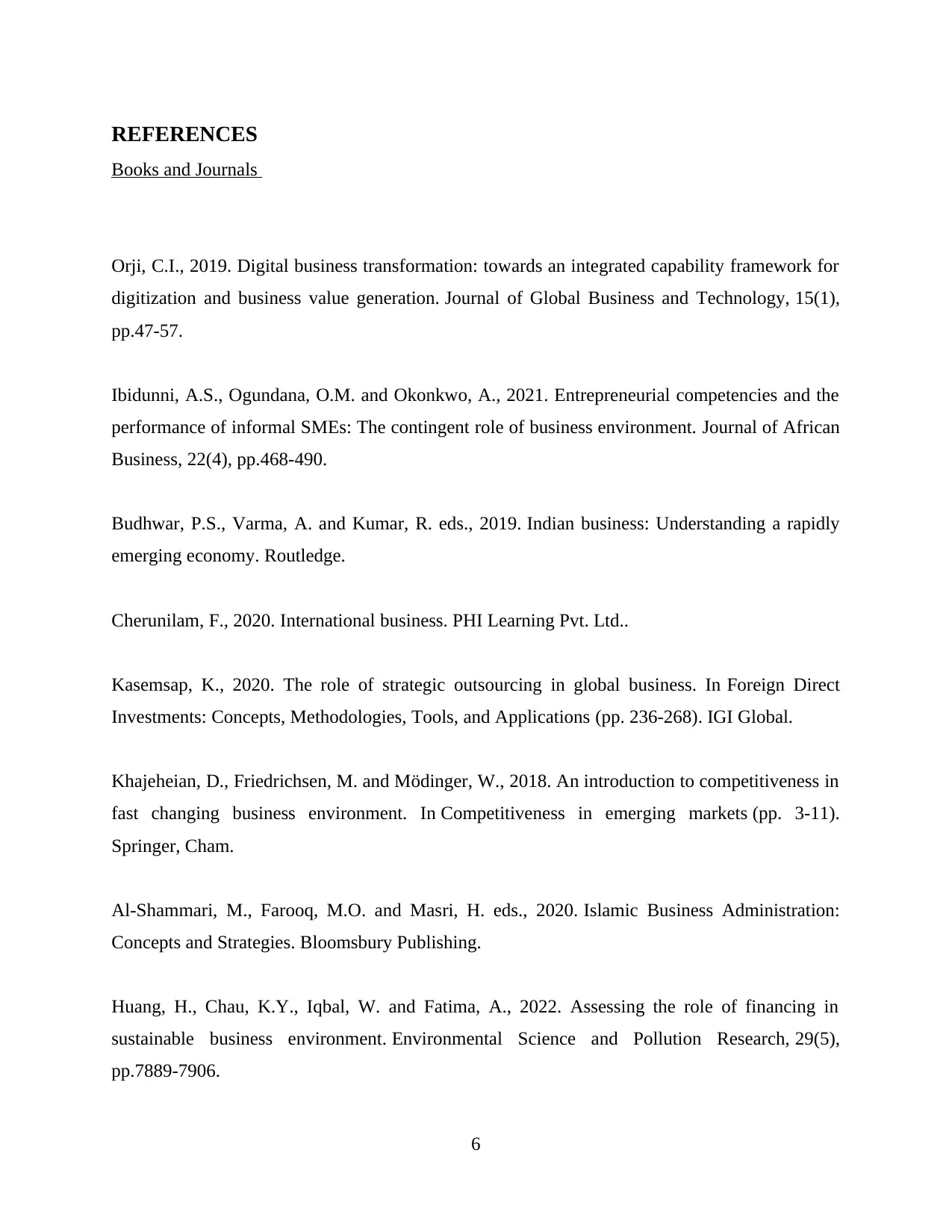
REFERENCES
Books and Journals
Orji, C.I., 2019. Digital business transformation: towards an integrated capability framework for
digitization and business value generation. Journal of Global Business and Technology, 15(1),
pp.47-57.
Ibidunni, A.S., Ogundana, O.M. and Okonkwo, A., 2021. Entrepreneurial competencies and the
performance of informal SMEs: The contingent role of business environment. Journal of African
Business, 22(4), pp.468-490.
Budhwar, P.S., Varma, A. and Kumar, R. eds., 2019. Indian business: Understanding a rapidly
emerging economy. Routledge.
Cherunilam, F., 2020. International business. PHI Learning Pvt. Ltd..
Kasemsap, K., 2020. The role of strategic outsourcing in global business. In Foreign Direct
Investments: Concepts, Methodologies, Tools, and Applications (pp. 236-268). IGI Global.
Khajeheian, D., Friedrichsen, M. and Mödinger, W., 2018. An introduction to competitiveness in
fast changing business environment. In Competitiveness in emerging markets (pp. 3-11).
Springer, Cham.
Al-Shammari, M., Farooq, M.O. and Masri, H. eds., 2020. Islamic Business Administration:
Concepts and Strategies. Bloomsbury Publishing.
Huang, H., Chau, K.Y., Iqbal, W. and Fatima, A., 2022. Assessing the role of financing in
sustainable business environment. Environmental Science and Pollution Research, 29(5),
pp.7889-7906.
6
Books and Journals
Orji, C.I., 2019. Digital business transformation: towards an integrated capability framework for
digitization and business value generation. Journal of Global Business and Technology, 15(1),
pp.47-57.
Ibidunni, A.S., Ogundana, O.M. and Okonkwo, A., 2021. Entrepreneurial competencies and the
performance of informal SMEs: The contingent role of business environment. Journal of African
Business, 22(4), pp.468-490.
Budhwar, P.S., Varma, A. and Kumar, R. eds., 2019. Indian business: Understanding a rapidly
emerging economy. Routledge.
Cherunilam, F., 2020. International business. PHI Learning Pvt. Ltd..
Kasemsap, K., 2020. The role of strategic outsourcing in global business. In Foreign Direct
Investments: Concepts, Methodologies, Tools, and Applications (pp. 236-268). IGI Global.
Khajeheian, D., Friedrichsen, M. and Mödinger, W., 2018. An introduction to competitiveness in
fast changing business environment. In Competitiveness in emerging markets (pp. 3-11).
Springer, Cham.
Al-Shammari, M., Farooq, M.O. and Masri, H. eds., 2020. Islamic Business Administration:
Concepts and Strategies. Bloomsbury Publishing.
Huang, H., Chau, K.Y., Iqbal, W. and Fatima, A., 2022. Assessing the role of financing in
sustainable business environment. Environmental Science and Pollution Research, 29(5),
pp.7889-7906.
6
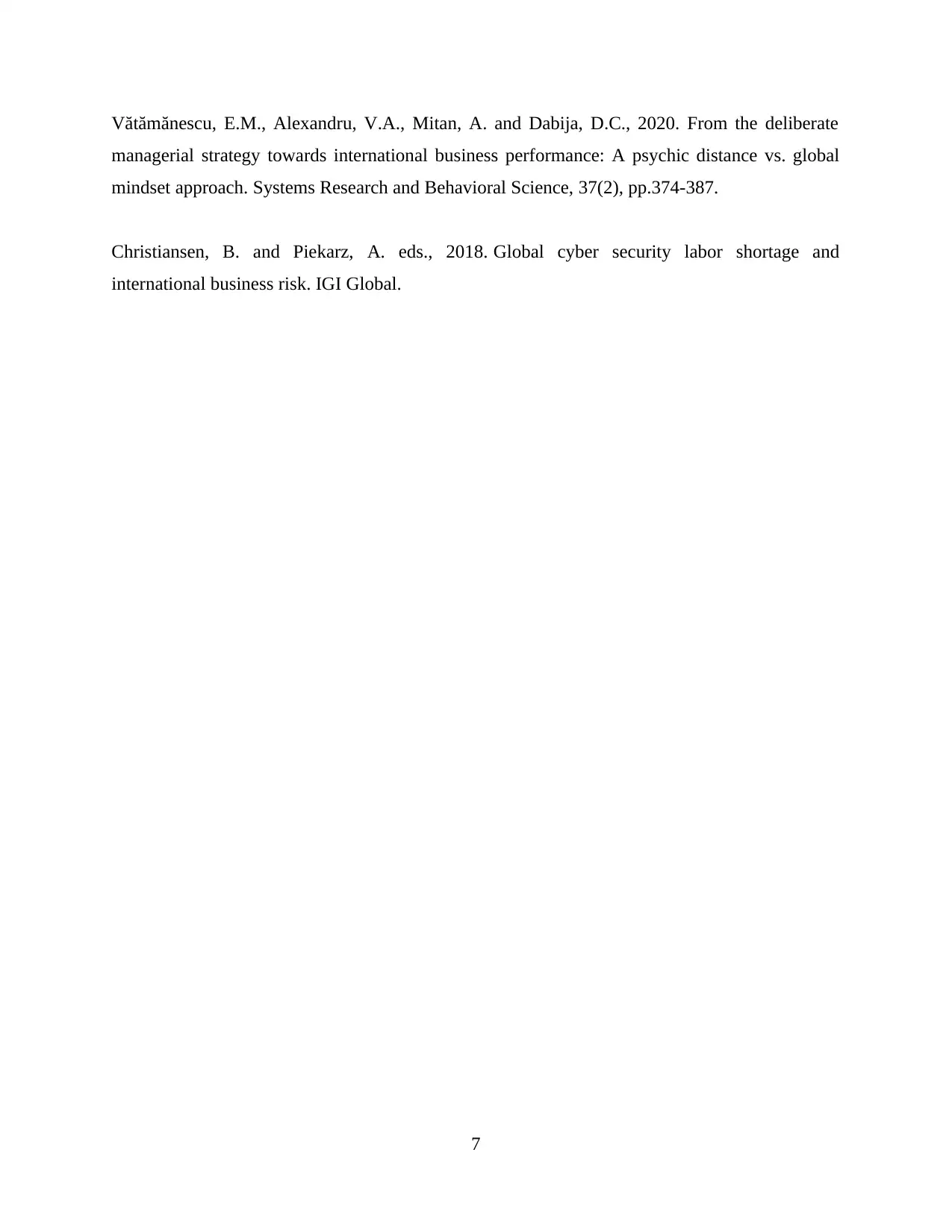
Vătămănescu, E.M., Alexandru, V.A., Mitan, A. and Dabija, D.C., 2020. From the deliberate
managerial strategy towards international business performance: A psychic distance vs. global
mindset approach. Systems Research and Behavioral Science, 37(2), pp.374-387.
Christiansen, B. and Piekarz, A. eds., 2018. Global cyber security labor shortage and
international business risk. IGI Global.
7
managerial strategy towards international business performance: A psychic distance vs. global
mindset approach. Systems Research and Behavioral Science, 37(2), pp.374-387.
Christiansen, B. and Piekarz, A. eds., 2018. Global cyber security labor shortage and
international business risk. IGI Global.
7
⊘ This is a preview!⊘
Do you want full access?
Subscribe today to unlock all pages.

Trusted by 1+ million students worldwide

8
1 out of 10
Related Documents
Your All-in-One AI-Powered Toolkit for Academic Success.
+13062052269
info@desklib.com
Available 24*7 on WhatsApp / Email
![[object Object]](/_next/static/media/star-bottom.7253800d.svg)
Unlock your academic potential
Copyright © 2020–2025 A2Z Services. All Rights Reserved. Developed and managed by ZUCOL.



